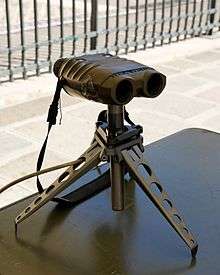CheyTac Intervention
| CheyTac Intervention | |
|---|---|
|
CheyTac Intervention M-200 rifle | |
| Type | Sniper rifle |
| Place of origin |
|
| Service history | |
| Used by | See Users |
| Production history | |
| Manufacturer | CheyTac LLC |
| Produced | 2001—present |
| Variants |
|
| Specifications | |
| Weight | 31 lb (14 kg) without scope (M-200) |
| Length | 53 in (1.34 m) (stock extended), 46¾ in (1.18 m) (stock collapsed) (M-200) |
| Barrel length | 29 (73.7 cm) in standard w/ 1:13 twist (M-200), 26 in (66 cm) optional. |
|
| |
| Cartridge | .408 Chey Tac or .375 Chey Tac |
| Action | Bolt action |
| Effective firing range |
2000+ m - M-200 2000+ m - M-200 Carbine 1500+ m - M-200 CIV (Civilian) 1800+ m - M-310 SS (Single Shot) 1800+ m - M-310 R (Repeater) |
| Feed system | 7-round detachable box magazine |
| Sights | Day or night optics |
The CheyTac Intervention is an American bolt-action sniper rifle manufactured by CheyTac LLC. It is fed by a 7-round detachable single-stack magazine. It fires .408 Chey Tac or .375 Chey Tac ammunition. CheyTac LLC states that the system is capable of delivering sub-MOA accuracy at ranges of up to 2,500 yards (2,300 m), one of the longest ranges of all modern-day sniper rifles. It is based on the EDM Arms Windrunner.
Cartridge, bullets and barrels
CheyTac specially developed the .408 CheyTac/.375 CheyTac cartridge for long-range use. The cartridge is optimized for accuracy by a balance of the rotational and linear drag, which reduces yaw and precession, and keeps the tip of the projectile pointed along the trajectory.
To achieve balanced flight the rifling twist rate for the .408 CheyTac chambering was chosen at 330.2 mm (1:13 in), with eight 0.4080 in diameter grooves, 0.4010 in diameter bore and a 0.050" land width, square cut, with no taper. The later .375 CheyTac round, developed from the .408 CheyTac, uses a 292 mm (1:11.5 in) rifling twist rate.
Accessories
Muzzle brake
The McArthur PGRS-1 muzzle brake can be used to reduce recoil. It was designed by gunsmith and firearm inventor, Bruce McArthur, owner of The Flint & Frizzen Gun Shop in Clarkston, Michigan.
Day and night optical sight systems
There are two different day optical sights available. The primary sight is the Nightforce NXS 5.5-22x56 variable magnification telescopic sight with a 56 mm objective. The alternate sight is the US Optics SN-9. The night vision system is the AN/PVS-14 GEN III Pinnacle monocular, which attaches to the day optic using the Monoloc device. An AN/PEQ-2 infrared laser provides additional lighting in low-light conditions. The device is attached to a titanium strut.[1]
Meteorological and environmental sensor package
The KESTREL 4000 (or, 4500 NV) meteorological and environmental sensor package measures the wind speed, air temperature, air pressure, relative humidity, wind chill, and dew point. The KESTREL 4500 NV model is compatible with night vision devices.[1][2]
Laser rangefinder

A Vector IV mil spec laser rangefinder measures distances up to 6 km (3.7 mi), and houses a digital compass and class 1 eye safe filters.[1]
Advanced Ballistic Computer
The CheyTac Advanced Ballistic Computer (ABC) System software package uses tabulated bullet flight data derived from high speed Doppler radar test sessions, and mathematical models to predict ballistic trajectory. It runs on Windows Mobile 2003 and receives input from the Kestrel handheld weather station and Vector IV laser rangefinder binoculars.[1] However, much like other ballistic prediction software, when rounds are used for which no Doppler Radar-established bullet flight data is known, the ABC System relies solely on mathematical ballistic models like all other ballistic prediction computer programs. Printed data tables are available for manual use.[1] Without computer support the effectiveness of some long-range shooters could be severely reduced, since they may rely heavily on computer support to obtain correct ballistic solutions.
Capabilities
Records
The Intervention holds the world record for best group at a distance, landing 3 bullets within 16⅝ inches (42 cm) at 2,321 yards (2,122 m) near Arco in Idaho.[3]
On the Discovery Channel TV show Future Weapons April 9, 2007, episode "Massive Attack" the host Richard Machowicz, a former United States Navy SEAL, made 3 out of 6 shots, hitting a human-sized sheet of metal at a distance of 2,530 yards (2,313 m) at Arco Pass in Idaho.
Accuracy
CheyTac states that "the CheyTac LRRS is a solid anti-personnel system to 2,000 yards (1,830 m)." The primary intent of the .408 is as an extreme range anti-personnel system. Groups of 7–9 inches (18–23 cm) at 1,000 yards (914 m), 10 inches (25 cm) at 1500 yards (1372 m) and 15 inches (38 cm) at 2,000 yards (1,829 m) have been consistently obtained.[4][5]
Groups of 19 inches (48 cm) at 2,100 yards (1,920 m) and 29 inches (74 cm) at 2,400 yards (2,195 m) have also been obtained. All groups that are up to 3,000 yards (2,743 m) are less than 1 minute of angle for vertical dispersion.[1]
Versions
The CheyTac Intervention comes in several variants:[6]
- M-200 (29 in (737 mm) barrel length)
- M-200 Carbine (Now out of production)
- M-310 (Single shot and repeater sub-variants all with 29 in (737 mm) barrel length)
- M-325 (Single shot, repeater and tactical sub-variants all with 28 in (711 mm) barrel length)
The main capability differences between the different versions are governed by barrel length which determines the obtainable muzzle velocity. Higher muzzle velocity extends the effective range of a rifle, everything else being equal. The M-200 and the M-200 Carbine are and were limited to official customers like militaries and come with a detachable box magazine and a telescopic stock, whilst the current (2013) other variants have a glass-fiber fixed McMillan A5 stock and are available for the general public.[6]
Users
 Argentina: Used by Amphibious Commandos Group.
Argentina: Used by Amphibious Commandos Group. Jordan: Used by Jordanian SRR-61 Regiment.
Jordan: Used by Jordanian SRR-61 Regiment. Poland: Used by GROM operatives.[7]
Poland: Used by GROM operatives.[7] Turkey: Used by Maroon Berets operatives.[8][9]
Turkey: Used by Maroon Berets operatives.[8][9]
References
- 1 2 3 4 5 6 Chey Tac Information Papers
- ↑ Kestrel 4000 Pocket Weather Tracker
- ↑ http://uktactical.webs.com/408cheytachunter.htm https://web.archive.org/web/20100817233824/http://uktactical.webs.com/408cheytachunter.htm
- ↑ Doing MOA capability testing is expensive. This is done by shooting 100 shots, no less than 2 minutes between each shot, correcting for conditions on each shot at 90% of the gun's supersonic range. You count the number of shots within an x MOA diameter. 80% of those shots in an x MOA arc within 90% of supersonic capability gives a REAL MOA value capability for a military grade long range rifle. If 80% of those shots fall within 0.9 MOA, then that is the gun's capability. If humans are shooting the guns, then you should use at least 5 shooters and average the values. Of course, a gun's individual capability should be tested at 200 yards (180 m) to determine if the gun can hold a real group or not. We did this with the .408 in 2001 and 2002. Gives honest numbers, but costs a lot. (statement by Mr. Dean Michaelis, former co-owner and test shooter of CheyTac LLC)
- ↑ Statistical notes on rifle group patterns by Robert E. Wheeler
- 1 2 CheyTac's Website
- ↑ Meter, Sebastian. "GROM Utility and Equipment" (in Polish). Gdansk House Publishing. Retrieved 2009-08-02.
- ↑ http://www.militaryfactory.com/smallarms/detail.asp?smallarms_id=474
- ↑ YouTube video about the Bordo Bereliler (Maroon Berets) showing a CheyTac Intervention rifle at about 3:40 (in Turkish)
